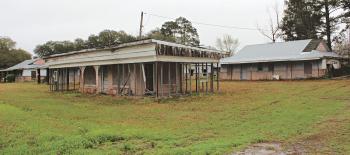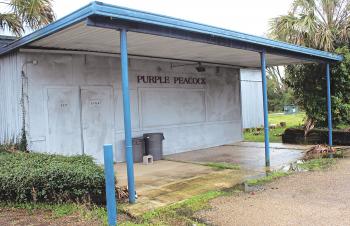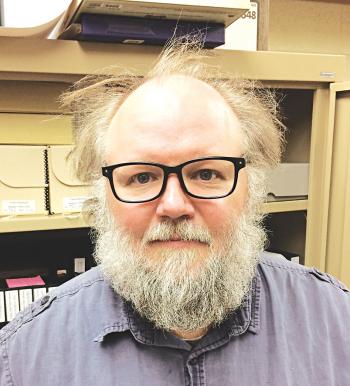
The Oleander, located on the west side of Eunice, featured a motel, restaurant and a lounge called the Pony Room. Eunice was once home to about 30 dance halls, including the Pony Room.
(The Eunice News Photo by Claudette Olivier)

The Purple Peacock in Eunice opened in 1964 and, unlike many of the state’s dance halls, is still standing and occasionally still open for business. John Sharp, keeper of www.louisiana dancehalls.com, is looking for stories, comments or corrections, information, photographs or video from more than 1,600 dance halls that once dotted the state.
(The Eunice News Photo by Claudette Olivier)
Dance hall memories
“Turn at the Wagon Wheel” was no doubt once part of driving directions in L’Anse Aux Pailles, but since the Hicks Wagon Wheel dance hall burned down in the 1970s, locations of many such clubs have long been forgotten.
But if John Sharp of the Center for Louisiana Studies has anything to do with it, the memory of the club immortalized in the song “Hicks Wagon Wheel Special” will never be erased.
“I come across music quite a lot in my work, but as a non-French speaker, I wondered why some of the songs were in English and not in French,” Sharp said. “It’s some of those songs that got me interested in this project. I wanted to know more about the places they were singing about in the ‘Hicks Wagon Wheel Special,’ ‘B.O. Sparkle Waltz’ and ‘Chinaball Special.’”
“I wanted to see what these places looked like, but lots of them are gone.”
Sharp serves as assistant director for Research at the Center for Louisiana Studies at the University of Louisiana at Lafayette, which includes the Archives of Cajun and Creole Folklore, and is treasurer of the Louisiana Folklore Society.
His pursuit of information on Louisiana’s dance halls has also added keeper and researcher of www.LouisianaDancehalls.com to his resume. The website features more than 1,600 dance halls listings from Shreveport to the banks of the Mississippi River in East Carroll Parish to Holly Beach to lower Plaquemines Parish. Many of these dance halls are long gone in the physical sense, but Sharp has more than 600 images on the website, ranging from late 1800s newspaper clippings about house dances, dance hall advertisements, matchbooks, unknown halls on old insurance maps, photographs and videos.
Information is organized by dance hall name, town or parish, and whatever information is available about each locale is displayed under its name. Website visitors may leave comments or corrections, information or photographs on any of the listings. Sharp may also be reached by phone at 337-482-1320.
“Things are hard to find,” Sharp said. “Cameras were an expensive thing back then. There weren’t phones with cameras in everybody’s pockets back in those days. I’m trying to put as much together as can. I had no clue when this started out that there would be so many clubs and dance halls.”
“I jumped in way over my head from the get go,” he added, laughing.
Of the 1,600 plus dance halls in the state, St. Landry Parish was home to almost 200, and this high concentration of venues was only shared with Lafayette Parish and the New Orleans area.
“St. Landry Parish has two sizable cities, Eunice and Opelousas,” Sharp said. “If you look at the website, there were almost 200 dance halls in the parish, and about 70 of them were in Opelousas and about 30 were in Eunice. That’s 100 for the two towns and 100 for the rest of the parish. That’s pretty impressive.”
According to Sharp, the railroad and LSU Eunice were two of the reasons so many dance halls dotted the landscape of Eunice, and Opelousas’ early years as a trading post as well as rail road access likely had something to do with the number of clubs located there.
“Where you have people, you have entertainment,” Sharp said. “That’s got a good bit to do with it. Another reason is it’s fun to travel to another town. Sometimes there were clubs for every aspect of the population.”
Dance halls in Eunice once included places like Charles Matte’s Dance Hall, the Chicken Shack, City Limit, Club 26, Crystal Cocktail Lounge, Domino Lounge, Dup’s Beer Garden, Etley’s Lounge, Fruge’s Pleasure Club, Miller’s Beer Garden, Pony Room Lounge, Powell Cocktail Lounge and even an unknown night club located on the corner of Laurel Avenue and South Beulah Street, which was noted on a 1946 Sanborn Insurance map. Eunice dance halls listed on the website that are still standing and operating include the Barn at Lakeview, Gilton’s (now Chateau De Memories), the Liberty Theater, Nick’s on 2nd (now Ruby’s Restaurant and Courtyard) and the Purple Peacock.
Of the dance halls once located in Eunice, Sharp is very interested in getting information on Abe’s Palace, the Blue Goose, the Dixie Club, Gilton’s, the Green Wing, the Lakeview Club and the Silver Slipper.
Since the website went live Feb. 9, Sharp has fielded several dozen comments through the site as well as a few dozen phone calls from folks looking to share dance hall stories.
“I’m doing pretty good,” Sharp said. “I’m getting calls from 90-year-olds. Some calls are from people who say the club belonged to someone in their family or it was their ‘spot.’ People want to be represented, and I can appreciate that. I even got a message from some people in Europe who went to Gilton’s once and said they danced to zydeco.”
When it comes to the types of stories Sharp collects, the researcher said there are three main reasons why people want to share their dance hall memories.
“One is that their parents made them go there, and they hated the music,” Sharp said, laughing. “Two is for love. They either met their wife or husband there or took dates there. The third is usually recalling a fight at a dance hall.”
Sharp sees the launch of the website as his biggest milestone so far in the project, and he hopes the 24/7 access will encourage people to share their stories. Sharp said he has not received much feedback from the Eunice area yet, and his distance from dance hall locations is the biggest hurdle to getting localized and reliable information.
In his quest, Sharp has gleaned some interesting information about some of the dance halls of St. Landry Parish.
“When I was looking on the Internet, the Silver Slipper (the one located in near Eunice) was actually mentioned in the JFK assassination,” Sharp said. “I didn’t expect that.”
Whispers of illegal gambling, prostitution and Mafia-like activity also swirl around many of the bygone parish dance halls, especially those that were open when Cat Doucet was sheriff of the parish from 1936-1940 and from 1952-1968. Fights were also common at area dance halls, especially when single men or women from other towns or groups of people from other towns traveled to out of town bars.
“Single outsiders were viewed as possibly taking away a partner or mate,” Sharp said. “There are lots of stories like these from places that were located on parish lines.”
“Communities had these strangely tribal feuds,” he added, laughing.
“There was a story I heard about Ville Platte and a certain club. If someone there mentioned they were from Mamou, a fight broke out.”
Using a Louisiana Filmmakers Grant, Sharp is turning the material gathered in his research and filmed interviews into a full-length documentary called “Dance Halls of Louisiana.” The documentary will be completed and screened later this year.
- Log in to post comments

